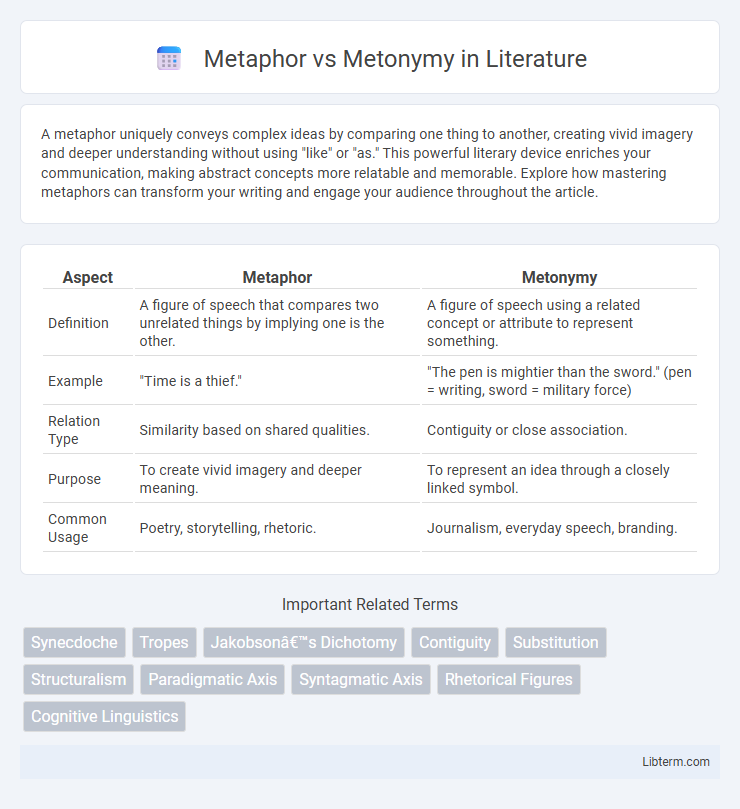A metaphor uniquely conveys complex ideas by comparing one thing to another, creating vivid imagery and deeper understanding without using "like" or "as." This powerful literary device enriches your communication, making abstract concepts more relatable and memorable. Explore how mastering metaphors can transform your writing and engage your audience throughout the article.
Table of Comparison
| Aspect | Metaphor | Metonymy |
|---|---|---|
| Definition | A figure of speech that compares two unrelated things by implying one is the other. | A figure of speech using a related concept or attribute to represent something. |
| Example | "Time is a thief." | "The pen is mightier than the sword." (pen = writing, sword = military force) |
| Relation Type | Similarity based on shared qualities. | Contiguity or close association. |
| Purpose | To create vivid imagery and deeper meaning. | To represent an idea through a closely linked symbol. |
| Common Usage | Poetry, storytelling, rhetoric. | Journalism, everyday speech, branding. |
Introduction to Metaphor and Metonymy
Metaphor and metonymy are fundamental figures of speech in linguistics and literature, each representing distinct cognitive processes of language use. Metaphor involves understanding one concept in terms of another through analogy, such as "time is a river," highlighting shared qualities between disparate domains. Metonymy operates through association or contiguity, like using "the crown" to represent royal authority, emphasizing proximity-based reference rather than similarity.
Defining Metaphor: Meaning and Usage
Metaphor is a figure of speech in which one concept is described in terms of another, creating an implicit comparison that highlights shared characteristics to enhance meaning. It operates by transferring qualities from a familiar source domain to a target domain, enriching language with vivid imagery and abstract connections. Commonly used in literature, everyday communication, and cognitive processes, metaphor facilitates understanding complex or intangible concepts through relatable terms.
Understanding Metonymy: Meaning and Examples
Metonymy is a figure of speech where a concept is referred to by the name of something closely associated with it, such as using "the crown" to signify royal authority. Unlike metaphor, which draws comparisons based on similarity, metonymy relies on a direct relationship, like using "Hollywood" to represent the American film industry. Understanding metonymy enhances comprehension of language nuances by recognizing these associative connections in communication.
Key Differences Between Metaphor and Metonymy
Metaphor involves describing one concept by directly relating it to another based on similarity, such as "Time is a thief," whereas metonymy substitutes a word with another closely related term, like using "the crown" to represent monarchy. The key difference lies in metaphor's reliance on analogy versus metonymy's basis in association or contiguity. Metaphors bridge distinct domains to highlight shared traits, while metonymy uses a part, attribute, or related entity to stand in for the whole or concept.
Historical Evolution of Metaphor and Metonymy
Metaphor and metonymy have evolved distinctly within linguistic and cognitive frameworks, with metaphor historically rooted in the Aristotelian tradition as a figure of speech involving implicit comparison between unrelated concepts. Metonymy, emerging from classical rhetoric, functions through associative relationships, where a term substitutes for another closely linked entity, such as "the crown" representing monarchy. Over centuries, scholars like Roman Jakobson have emphasized their cognitive roles, positioning metaphor as a process of similarity-based mapping and metonymy as a contiguity-driven association, reflecting their fundamental differences and intertwined evolution in language and thought.
Cognitive Functions of Metaphor and Metonymy
Metaphor facilitates cognitive processing by enabling individuals to understand abstract concepts through concrete experiences, enhancing comprehension and problem-solving by mapping familiar domains onto unfamiliar ones. Metonymy operates by linking related concepts within the same cognitive domain, allowing for efficient retrieval of information and communication through associative references. Both cognitive functions underpin language and thought, with metaphor driving conceptual abstraction and metonymy supporting categorical organization and contextual understanding.
Metaphor and Metonymy in Everyday Language
Metaphor and metonymy both shape everyday language by enhancing meaning through comparison and association, respectively. Metaphors create understanding by linking unrelated concepts based on shared qualities, such as "time is a thief," while metonymy uses closely related terms, like "the crown" to represent royalty. These linguistic tools streamline communication and enrich expression in daily conversations, literature, and media.
Literary Analysis: Metaphor vs Metonymy
Metaphor involves describing one concept through another to highlight similarity, enriching literary texts by fostering vivid imagery and deeper emotional resonance. Metonymy replaces a term with a related concept, emphasizing contextual links that reveal cultural or thematic subtexts within a narrative. Understanding the distinction between metaphor and metonymy enhances literary analysis by uncovering layers of meaning and authorial intent in symbolism and character development.
Common Misconceptions and Overlaps
Metaphor and metonymy are distinct rhetorical devices often confused due to their conceptual overlap in figurative language. Metaphor involves understanding one concept in terms of another, highlighting similarity, whereas metonymy relies on contiguity, representing something through a related attribute or association. Common misconceptions include treating them as interchangeable, but careful linguistic analysis shows metaphor abstracts meaning across domains, while metonymy operates within the same cognitive domain through direct relationships.
Conclusion: The Impact of Metaphor and Metonymy in Communication
Metaphor and metonymy significantly enhance communication by shaping how concepts and relationships are understood and conveyed. Metaphors facilitate abstract thinking by linking disparate ideas through similarity, while metonymy relies on contextual associations, grounding meaning in related concepts. Together, these rhetorical devices deepen cognitive processing and enrich expressive potential in language.
Metaphor Infographic

 libterm.com
libterm.com